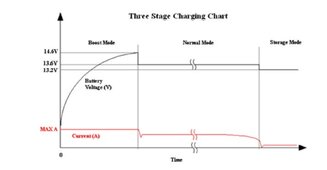krby
Solar Enthusiast
TL;DR:
For various reasons, I'm using 14.4V bulk, 13.4V absorb, and 13.0V float voltages for an AGM SLA battery bank. Is this ok? I'm concerned the batteries might never get fully charged.
Full background and question below:
Background
I have put together a DIY UPS for my home network rack. Max load is no more than 300W on the AC side, typical is 150-200W. If I shut down the NAS, it's about 50-60W. I sized (accounting for various losses and the 20% DoD in the next paragraph) this DIY UPS to run about 2.5 days with the NAS off. I cobbled together an Arduino + sensors that pretends to be a USB UPS interface and alerts the NAS when the AC goes out so it can shut down.
I chose AGM SLAs for this. The usage pattern for these batteries is they sit on low garage shelf so weight is not a concern They are 100% charged nearly all of the time, but during an power outage will drain down to 20% remaining or deeper. I know the deep discharge is going to shorten their life of the batteries. But, this will happen maybe 4-6 times a year, and not every time will be down to 20%. Also, the discharge current is about 5A for a 400Ah bank, so I'm not asking a lot. I expect to get at least 5 years out of them this way. If I'm wrong, I'll replace them when I discover that or some new battery tech tempts me.
The equipment is
The Powermax has a Bulk, Absorb, Float charge profile. With a pot on the Powermax, I can set the peak voltage for bulk mode, then absorb is -1.0V from bulk peak, and float is -0.4V lower than absorb. The charger does CC until it hits the bulk peak, then CV at absorb and float. I don't know if the Powermax uses time or tail current to switch from bulk -> absorb, float. It wasn't expensive, so maybe just time?
The Powermax defaults to 14.6V for bulk (so 13.6V absorb and 13.2V for float). It turns out my AIMS inverter has an input range of 10-15VDC, but that 15V is +/- 0.5V. When bench testing a few months ago, wiring the AIMS inverter directly to the Powermax charger tripped the inverter's overvoltage protection often (not every time). I want to be sure the inverter doesn't turn off when AC mains power returns after an outage, so I turned down the bulk peak voltage down to 14.4V (checked with a known good multimeter when powering on the charger with no load)
Finally, my question!
So, I ended up with 14.4V for bulk, 13.4V for absorb, and 13.0V for float. Is this ok? Looking at the Renogy voltage chart 13.0V is just at fully charged for their AGM batteries.
For various reasons, I'm using 14.4V bulk, 13.4V absorb, and 13.0V float voltages for an AGM SLA battery bank. Is this ok? I'm concerned the batteries might never get fully charged.
Full background and question below:
Background
I have put together a DIY UPS for my home network rack. Max load is no more than 300W on the AC side, typical is 150-200W. If I shut down the NAS, it's about 50-60W. I sized (accounting for various losses and the 20% DoD in the next paragraph) this DIY UPS to run about 2.5 days with the NAS off. I cobbled together an Arduino + sensors that pretends to be a USB UPS interface and alerts the NAS when the AC goes out so it can shut down.
I chose AGM SLAs for this. The usage pattern for these batteries is they sit on low garage shelf so weight is not a concern They are 100% charged nearly all of the time, but during an power outage will drain down to 20% remaining or deeper. I know the deep discharge is going to shorten their life of the batteries. But, this will happen maybe 4-6 times a year, and not every time will be down to 20%. Also, the discharge current is about 5A for a 400Ah bank, so I'm not asking a lot. I expect to get at least 5 years out of them this way. If I'm wrong, I'll replace them when I discover that or some new battery tech tempts me.
The equipment is
- Two 12V Renogy 200Ah AGMs wired in parallel (got a good deal a while back)
- AIMS 12V 600W Pure Sine Inverter (I had this already and know the network rack electronics run fine on it)
- Powermax PM4 55A converter/charger
The Powermax has a Bulk, Absorb, Float charge profile. With a pot on the Powermax, I can set the peak voltage for bulk mode, then absorb is -1.0V from bulk peak, and float is -0.4V lower than absorb. The charger does CC until it hits the bulk peak, then CV at absorb and float. I don't know if the Powermax uses time or tail current to switch from bulk -> absorb, float. It wasn't expensive, so maybe just time?
The Powermax defaults to 14.6V for bulk (so 13.6V absorb and 13.2V for float). It turns out my AIMS inverter has an input range of 10-15VDC, but that 15V is +/- 0.5V. When bench testing a few months ago, wiring the AIMS inverter directly to the Powermax charger tripped the inverter's overvoltage protection often (not every time). I want to be sure the inverter doesn't turn off when AC mains power returns after an outage, so I turned down the bulk peak voltage down to 14.4V (checked with a known good multimeter when powering on the charger with no load)
Finally, my question!
So, I ended up with 14.4V for bulk, 13.4V for absorb, and 13.0V for float. Is this ok? Looking at the Renogy voltage chart 13.0V is just at fully charged for their AGM batteries.




